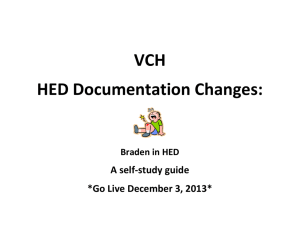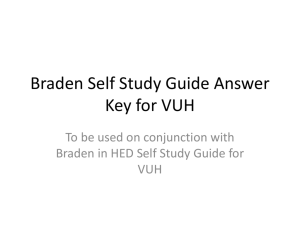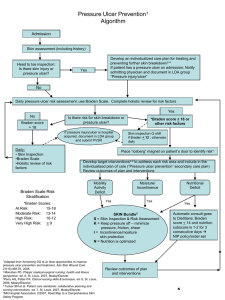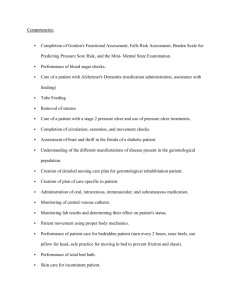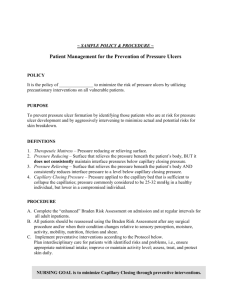Document
advertisement
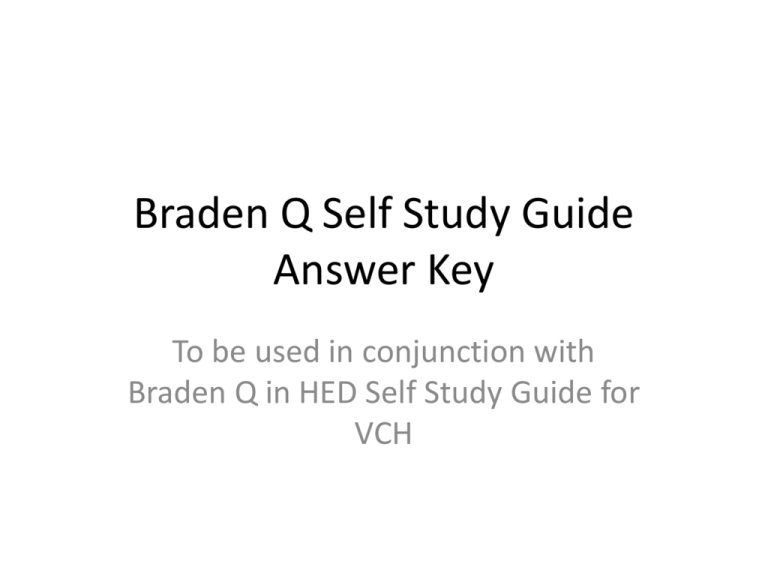
Braden Q Self Study Guide Answer Key To be used in conjunction with Braden Q in HED Self Study Guide for VCH Peds Scenario #1 Ally Doe is a 15 year old female admitted 2 days ago with Anorexia. She is ambulates in the halls and repositions herself in bed regularly. Skin warm & dry and pressure points are free of any redness, swelling, or irritation. She is alert and has no sensory deficits. She has lost 10 pounds over the last 2 months; she is on calorie counts with a sitter at the bedside. Ally eats less than half of meals provided. Vital signs are within normal limits. Based on this information, how would you score her Braden Q Pressure Ulcer risk level? Key points: 1) only significant risk factor is inadequate nutrition so Braden Q 26, standard risk 2) Nutrition problem will automatically display as a nutrition problem in Nutrition by Nursing section How would you document your plans to address her nutrition deficit Problem? • TPN? Tube Feeding Care? Special Diet? Monitor during meals? • Accurate I&O • Annotate & use Plan Priorities entry to individualize for this patient Peds Scenario #2: Andy Doe is a 4 month old male transferred to PCICU for post-op cardiac care. He is intubated, on IV pressors, with a mediastinal incision and chest tubes. In addition he is on paralytics and sedation. Skin is warm and dry. He has redness at the pulse oximetry site and a SP02 of 78. Andy is NPO and has had TPN and Lipids infusing for 48 hrs. . Based on this information, how would you score his Braden Q Pressure Ulcer risk level? Key points: 1. Several risk factors identified; Braden Q score 15, at risk. 2. Skin integrity risk and Skin incision problems identified 3. Incision assessment & care documented as usual 4. Activity and Nutrition problems also display under those care categories red Scenario #2, part 2: Andy developed a fever and is started on IV antibiotics. During the night the mediastinal incision opened spontaneously and is draining a moderate amount of odorless, purulent fluid. Andy has developed a diaper rash; other skin assessment is largely unchanged. How would you document his incision/wound? How would you determine what skin care treatment is needed, where would you find this information? Key points: 1. Moisture risk factor added; Braden Q score 14, at risk. 2. Problem changed to actual alteration in skin integrity & interventions documented 3. Incision assessment & care documented as usual red Peds Scenario #3, part 1: Susie Doe is an 8 year old female admitted with Cystic Fibrosis exacerbation. Susie ambulates within the room and repositions herself in bed regularly but with some difficulty due to weakness. Alert with no sensory deficits. Her mother states she has a poor appetite during an exacerbation and generally eats about half of meals provided. Susie’s SP02 is 88 on 3L O2 by nasal cannula. Skin warm & dry and pressure points are free of any redness, swelling, or irritation. Based on this information, how would you score her Braden Q Pressure Ulcer risk level? Key points: 1. Nutrition, Friction/Shear Risk, & Tissue Perfusion risk factors noted; Braden Q score 23, standard risk. 2. Skin assessment WNL but Nutrition Problem identified Peds Scenario #3, part 2: Susie SP02 drops to low 80s despite increase in O2 and there are changes in her chest x-ray. She is transferred to PICU. Susie’s put on Bipap. She rarely ambulates and struggles to reposition herself in bed due to increased work of breathing and weakness. Skin is warm and dry and pressure points free of redness, swelling or irritation. Hands and feet very pale, cool and numb. Susie rarely eats more than a few bites of any food offered. How would you score her Braden Q Pressure ulcer risk level? Key points: 1. Mobility and Friction/Shear problems noted; changes to Activity, Sensory Perception, and Nutrition Risk factors noted; Braden Q score 17, at risk. 2. Skin Integrity Risk & Mobility Problems identified Implications for Overall Plan of Care Plan of care should address risk factors for skin impairment in order to individualize plan for patient. • If nutrition risk factor, what will you do to support improved nutrition -TPN, Nutritional Supplements, Assist with feeding, etc. • If activity or mobility risk factor, what measures could you initiate to address – appropriate pressure redistribution devices, address fatigue by clustering activities, appropriate smooth moves equipment for repositioning, etc. • If moisture risk factors, how might you address – barrier sprays/creams, more frequent toileting or linen changes, etc. Focus on actions you as a nurse can take that directly impact outcomes for the patient. Samples for Patient with moisture, activity, & friction/shear risk: Plan Priorities: ensure condom catheter not leaking; cluster activities to conserve strength; use slippery sheets to reposition & foam to both elbows
